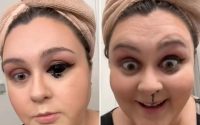Pimple patches are Gen Z’s most unique fashion accessory
Zit’s giving fashion.
Pimple patches are popping off as Gen Z turns a condition once considered an embarrassing marker of adolescence into an opportunity to accessorize.
No more hiding acne under layers of makeup for today’s tweens and young adults — they’re banishing blemish bashfulness by playfully placing the star, smiley face or fruit-shaped coverups to clear complexions and add to outfits.
“They’re cute yet effective,” Cree Payton, 29, explained to The Post. The New York City-based content creator proudly wears the trendy, colorful pieces of flair out in public when experiencing a breakout.
She appreciates that a patch can be “working its magic” — while “making a blemish look more ‘fun.’ “
Most pimple patches are medicated with hydrocolloid or salicylic acid to clear acne while also keeping the outbreak site protected from bacteria — not to mention the seduction to squeeze.
The playful pads are part of an ongoing skin-care craze — a global market that’s projected to grow from $184 billion in 2024 to $407 billion by 2035. The accidental accessories are reportedly being traded by youngsters during recess and endorsed by celebrities like Millie Bobby Brown, 20, who offers a selection via her skin-care line Florence By Mills.
“I think of them as little accessories. I’ve used them when I don’t have a blemish to enhance my outfit,” Clare Daly, 24, told The Post. “And the ones I use work to combat the core issue, so the zit goes away faster than if it wasn’t being treated and was left exposed.”
The freelance social media strategist admitted to feeling “so much more comfortable” wearing her favorite bump blankets from Glossier.
Brian Zak/NY Post
That’s good news for skin-eruption entrepreneurs like Julie Schott, 36, who started Starface — a popular patch company known for bold colors and creative shapes ranging from smiley faces to sour lemons.
“[Acne] is normal. This is part of growing up,” she told The Post. “Yet, it really can have an impact on your confidence and self-esteem.”
She became an expert on the issue during her time as a beauty editor at Elle and wanted to fix it. Clearly, the market was ready — 550 of Starface’s popular Hydro-Star stickers were sold every minute over the last two years.
“Being a young person is hard,” Schott said, noting that worrying about personal appearance is especially difficult and emotional during a person’s formative years.
“If we can make that easier, that’s what we’re here to do. There’s nothing wrong with having a breakout.”
However, the idea of boldly admitting to a breakout — much less wearing a bright sticker on your face isn’t something that’s spread too deep into older generations, at least not yet.
“I think it looks ridiculous,” Monica Bright, 29, told The Post, adding that the style seems “immature.”
“It’s so silly, like we’re all just walking around with stickers on our faces now? Where is the decorum? It’s screaming ‘I have a pimple’ to the world,” she said.
The Manhattanite prefers to maintain her skin-care routine in the privacy of her own bathroom — and cover the occasional outcropping with a dab of makeup.
Michael (who preferred to omit his last name), 31, echoed Bright’s sentiments.
“Why are all these weird Gen Z kids with already bad fashion choices now putting weird stars and s – – t on their face? What is this? Pre-K? They’re so bizarre!” he commented to The Post after spotting the trend on the streets in Williamsburg.
While possibly bizarre, medical experts have confirmed that most of these products do work to reduce acne by using ingredients that drain and absorb the pus from a pimple or cyst, moisturize the area, combat scarring and protect bacteria from entering the area.
“Pimple patches treat individual acne blemishes. They are a great option for targeted treatment,” Dr. Brendan Camp, a double-board certified dermatologist in New York and New Jersey, told The Post.
However, Dr. Howard Sobel, clinical dermatologic surgeon at Lenox Hill Hospital told The Post that pimple patches can “work as temporary spot treatments to help with bumps and blemishes,” but they “don’t actually prevent or clear acne flare-ups.”
He added that, from a medical standpoint, they’re safe to wear in public “but in regards to appearances, that is a personal preference.”
One that many Gen Zers are leaning into. Pimple patches have become so beloved by some that people are even adorning themselves with the stickers even when they don’t have a breakout.
Daly said it’s all about perspective: “Pimple patches are better looking than zits in the simplest sense!”


